How do you make an app with an actual fullscreen capabilities, that has the layout to be rendered underneath the notch?
Here's what I want:
Here's the code of what I've tried:
class MainActivity : Activity() {
override fun onCreate(savedInstanceState: Bundle?) {
super.onCreate(savedInstanceState)
setContentView(R.layout.activity_main)
if (Build.VERSION.SDK_INT >= Build.VERSION_CODES.P) {
// window.addFlags(WindowManager.LayoutParams.FLAG_FULLSCREEN)
val attrib = window.attributes
attrib.layoutInDisplayCutoutMode = WindowManager.LayoutParams.LAYOUT_IN_DISPLAY_CUTOUT_MODE_ALWAYS
layout_main.setOnApplyWindowInsetsListener { _, windowInsets ->
val inset = windowInsets.displayCutout
Log.d("Tag", "Inset: $inset")
windowInsets
}
}
}
}
The layout:
<?xml version="1.0" encoding="utf-8"?>
<android.support.constraint.ConstraintLayout xmlns:android="http://schemas.android.com/apk/res/android"
xmlns:app="http://schemas.android.com/apk/res-auto"
android:id="@+id/layout_main"
android:layout_width="match_parent"
android:layout_height="match_parent"
android:background="#3000FFFF"
android:fitsSystemWindows="true">
<View
android:layout_width="50dp"
android:layout_height="50dp"
android:background="#FFFF0000"
app:layout_constraintStart_toStartOf="parent"
app:layout_constraintTop_toTopOf="parent" />
<View
android:layout_width="50dp"
android:layout_height="50dp"
android:background="#FF00FF00"
app:layout_constraintEnd_toEndOf="parent"
app:layout_constraintTop_toTopOf="parent" />
<View
android:layout_width="50dp"
android:layout_height="50dp"
android:background="#FF0000FF"
app:layout_constraintBottom_toBottomOf="parent"
app:layout_constraintStart_toStartOf="parent" />
<View
android:layout_width="50dp"
android:layout_height="50dp"
android:background="#FFFF00"
app:layout_constraintBottom_toBottomOf="parent"
app:layout_constraintEnd_toEndOf="parent" />
<TextView
android:layout_width="0dp"
android:layout_height="0dp"
android:gravity="center"
android:text="Hello World!"
app:layout_constraintBottom_toBottomOf="parent"
app:layout_constraintEnd_toEndOf="parent"
app:layout_constraintStart_toStartOf="parent"
app:layout_constraintTop_toTopOf="parent" />
</android.support.constraint.ConstraintLayout>
The style:
<style name="AppTheme" parent="Theme.AppCompat.Light.NoActionBar">
<item name="colorPrimary">@color/colorPrimary</item>
<item name="colorPrimaryDark">@color/colorPrimaryDark</item>
<item name="colorAccent">@color/colorAccent</item>
<item name="android:windowNoTitle">true</item>
<item name="android:windowActionBar">false</item>
<item name="android:windowFullscreen">true</item>
<item name="android:windowContentOverlay">@null</item>
<item name="android:windowTranslucentStatus">true</item>
<item name="android:windowTranslucentNavigation">true</item>
</style>
Here's the Android Manifest:
<?xml version="1.0" encoding="utf-8"?>
<manifest xmlns:android="http://schemas.android.com/apk/res/android"
package="com.app.testandroidp">
<application
android:allowBackup="true"
android:icon="@mipmap/ic_launcher"
android:label="@string/app_name"
android:roundIcon="@mipmap/ic_launcher_round"
android:supportsRtl="true"
android:theme="@style/AppTheme">
<activity
android:name="com.app.testandroidp.MainActivity">
<intent-filter>
<action android:name="android.intent.action.MAIN" />
<category android:name="android.intent.category.LAUNCHER" />
</intent-filter>
</activity>
</application>
</manifest>
Here's the result that I've gotten so far:
I've tried setting different themes, setting the fullscreen flag in XML / Kotlin, setting the resizable activity in manifest, but the activity just won't get rendered under the notch.
For reference, this is the project's source code: https://gitlab.com/alvin.rusli/AndroidPTest



